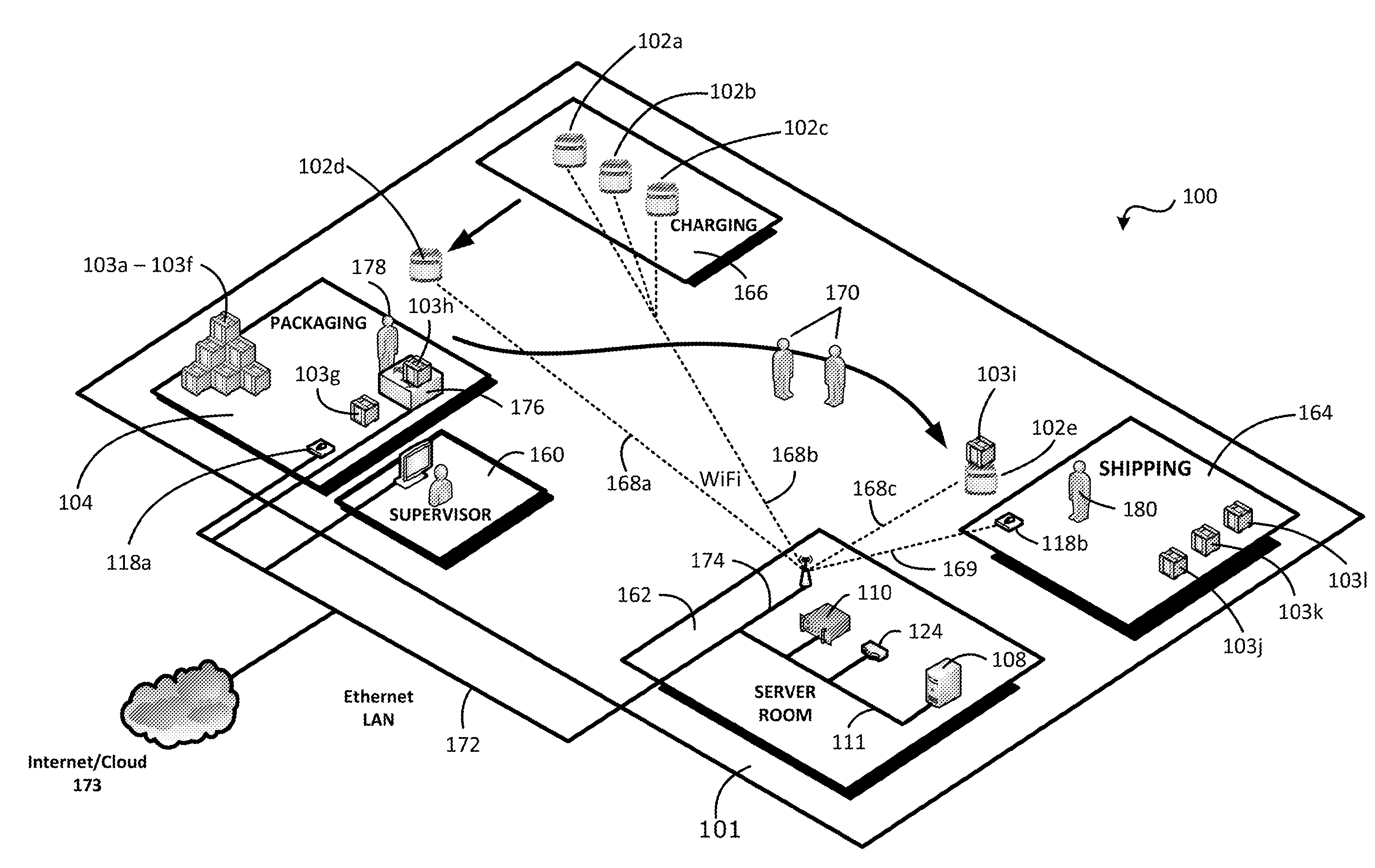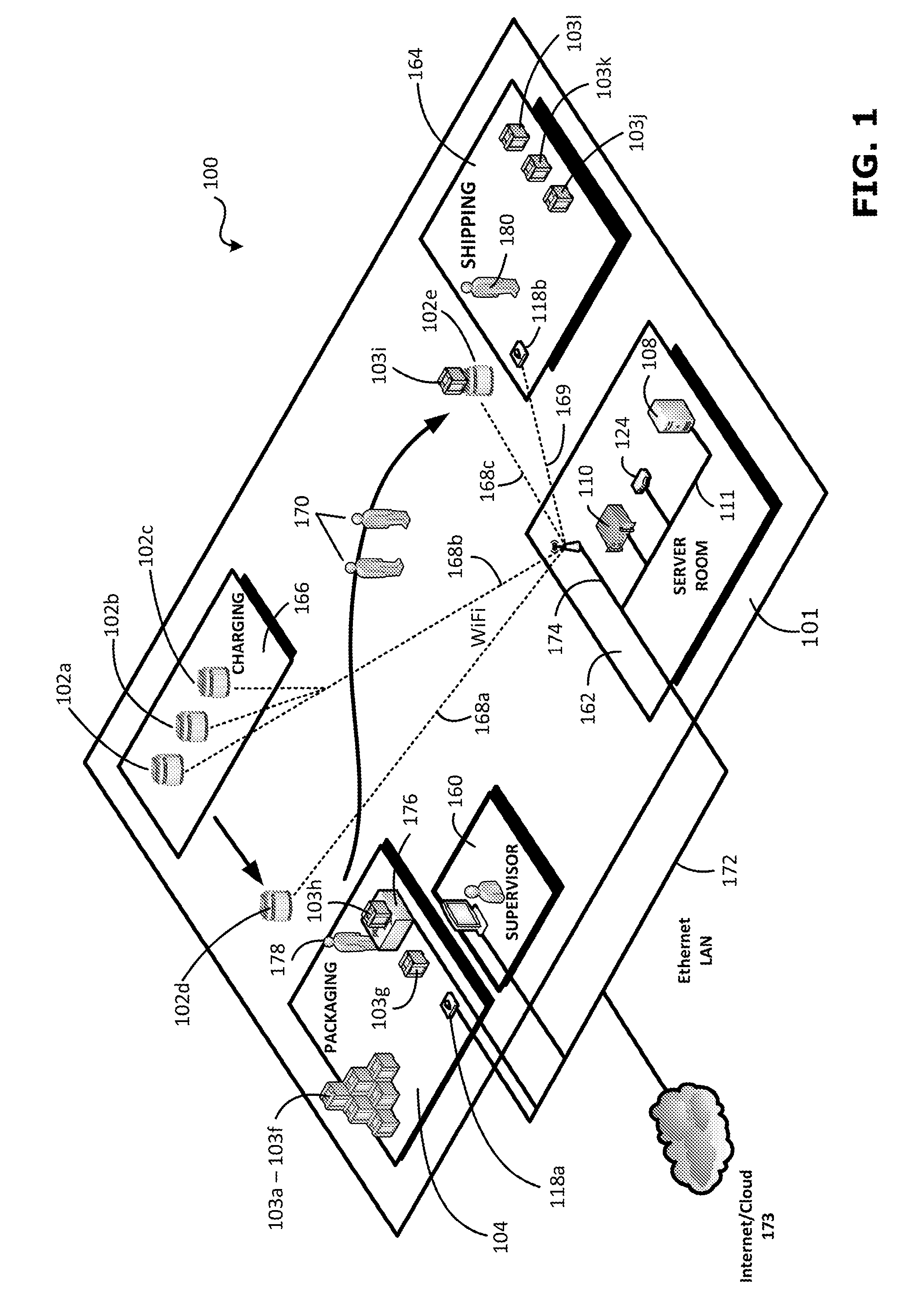Job management system for a fleet of autonomous mobile robots
a mobile robot and job management technology, applied in the direction of vehicle position/course/altitude control, process and machine control, instruments, etc., can solve the problems of increasing the risk of physical injury or death of human operators, increasing the risk of damage to expensive or rare equipment and inventory, and exposing the transported items and manufacturing equipment to higher contamination levels, so as to achieve favorable status and configuration, the effect of improving the quality of work
- Summary
- Abstract
- Description
- Claims
- Application Information
AI Technical Summary
Benefits of technology
Problems solved by technology
Method used
Image
Examples
examples
[0172]Following are several examples to demonstrate usage of the various commands. Lines that start with “QueueUpdate:” are messages that are broadcasted by the Job Management System.
##cel examples
QueueCancel Examples
[0173]
Example #1—cancelling a Pending item: QueueUpdate: PICKUP11 JOB11 10 Pending None Goal “t” None 12 / 19 / 2011 06:50:45 None None 0 queuecancel goal t abc QueueCancel: PICKUP11 JOB11 10 Cancelling None Goal “w20” None 12 / 16 / 2011 13:19:07 None None abc QueueUpdate: PICKUP11 JOB11 10 Cancelled None Goal “t” None 12 / 19 / 2011 06:50:45 12 / 19 / 2011 06:50:58 0Example #2—cancelling an InProgress item QueueUpdate: PICKUP8 JOB8 10 InProgress None Goal “w20” “MT-490” 12 / 16 / 2011 13:19:07 None None 0 queuecancel goal w20 abc QueueCancel: PICKUP8 JOB8 10 Cancelling None Goal “w20” None 12 / 16 / 2011 13:19:07 None None abc QueueUpdate: PICKUP8 JOB8 10 Interrupted None Goal “w20” None 12 / 16 / 2011 13:19:07 None None 0 QueueUpdate: PICKUP8 JOB8 10 Cancelled None Goal “w20” None 12 / 16 / 2011 13:19:07 12 / 16 / 2011 13:19:13 0Example #3—cancelling an InProgress item with reason QueueUpdate: PICKUP8 JOB8 10 InProgress None Goal “w20” “MT-490” 12 / 16 / 2011 13:19:07 None None 0 queuecancel goal w2...
##p examples
QueuePickup Examples
[0174]
Example #1—queuepickup with priority and JobID queuepickup z 11 xyz queuepickup goal “z” with priority 11, id PICKUP13 and job_id xyz successfully queued QueueUpdate: PICKUP13 xyz 11 Pending None Goal “z” None 12 / 19 / 2011 06:54:18 None None 0 QueueUpdate: PICKUP13 xyz 11 InProgress UnAllocated Goal “z” None 12 / 19 / 2011 06:54:18 None None 0 QueueUpdate: PICKUP13 xyz 11 InProgress Allocated Goal “z” None 12 / 19 / 2011 06:54:18 None None 0 QueueUpdate: PICKUP13 xyz 11 InProgress BeforePickup Goal “z” “Adept_Telepresence_Robot” 12 / 19 / 2011 06:54:18 None None 0 QueueUpdate: PICKUP13 xyz 11 InProgress EveryBefore Goal “z” “Adept_Telepresence_Robot” 12 / 19 / 2011 06:54:18 None None 0 QueueUpdate: PICKUP13 xyz 11 InProgress Before Goal “z” “Adept_Telepresence_Robot” 12 / 19 / 2011 06:54:18 None None 0 QueueUpdate: PICKUP13 xyz 11 InProgress Driving Goal “z” “Adept_Telepresence_Robot” 12 / 19 / 2011 06:54:18 None None 0 QueueUpdate: PICKUP13 xyz 11 InProgress After Goal “z” “Adept_T...
PUM
 Login to View More
Login to View More Abstract
Description
Claims
Application Information
 Login to View More
Login to View More - R&D
- Intellectual Property
- Life Sciences
- Materials
- Tech Scout
- Unparalleled Data Quality
- Higher Quality Content
- 60% Fewer Hallucinations
Browse by: Latest US Patents, China's latest patents, Technical Efficacy Thesaurus, Application Domain, Technology Topic, Popular Technical Reports.
© 2025 PatSnap. All rights reserved.Legal|Privacy policy|Modern Slavery Act Transparency Statement|Sitemap|About US| Contact US: help@patsnap.com



